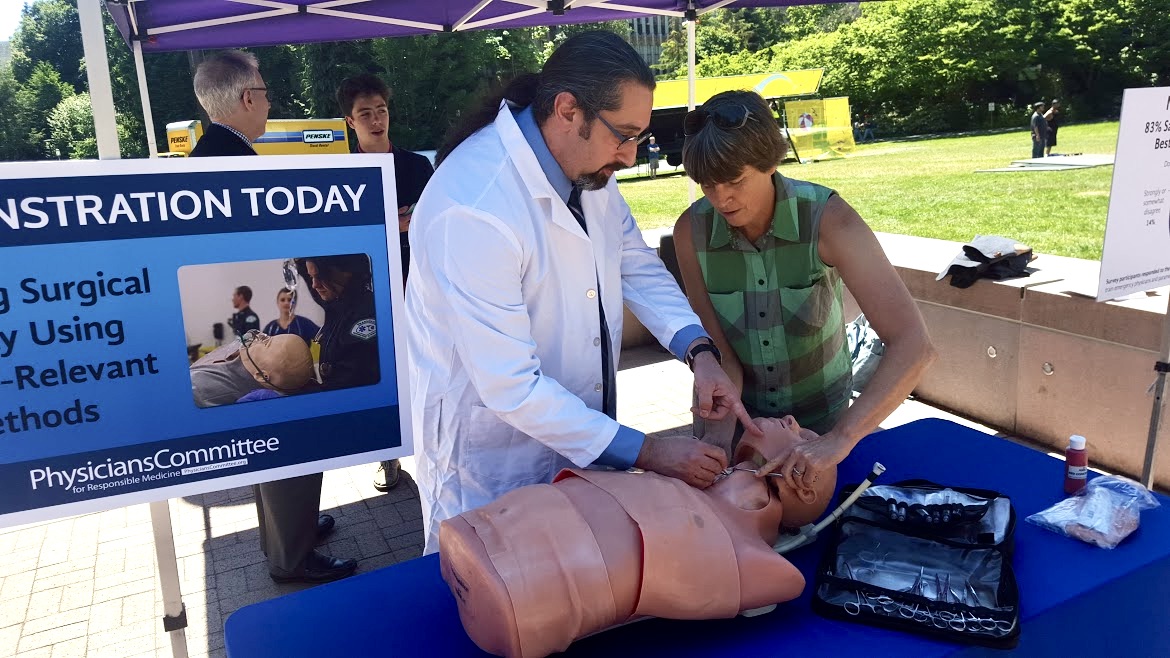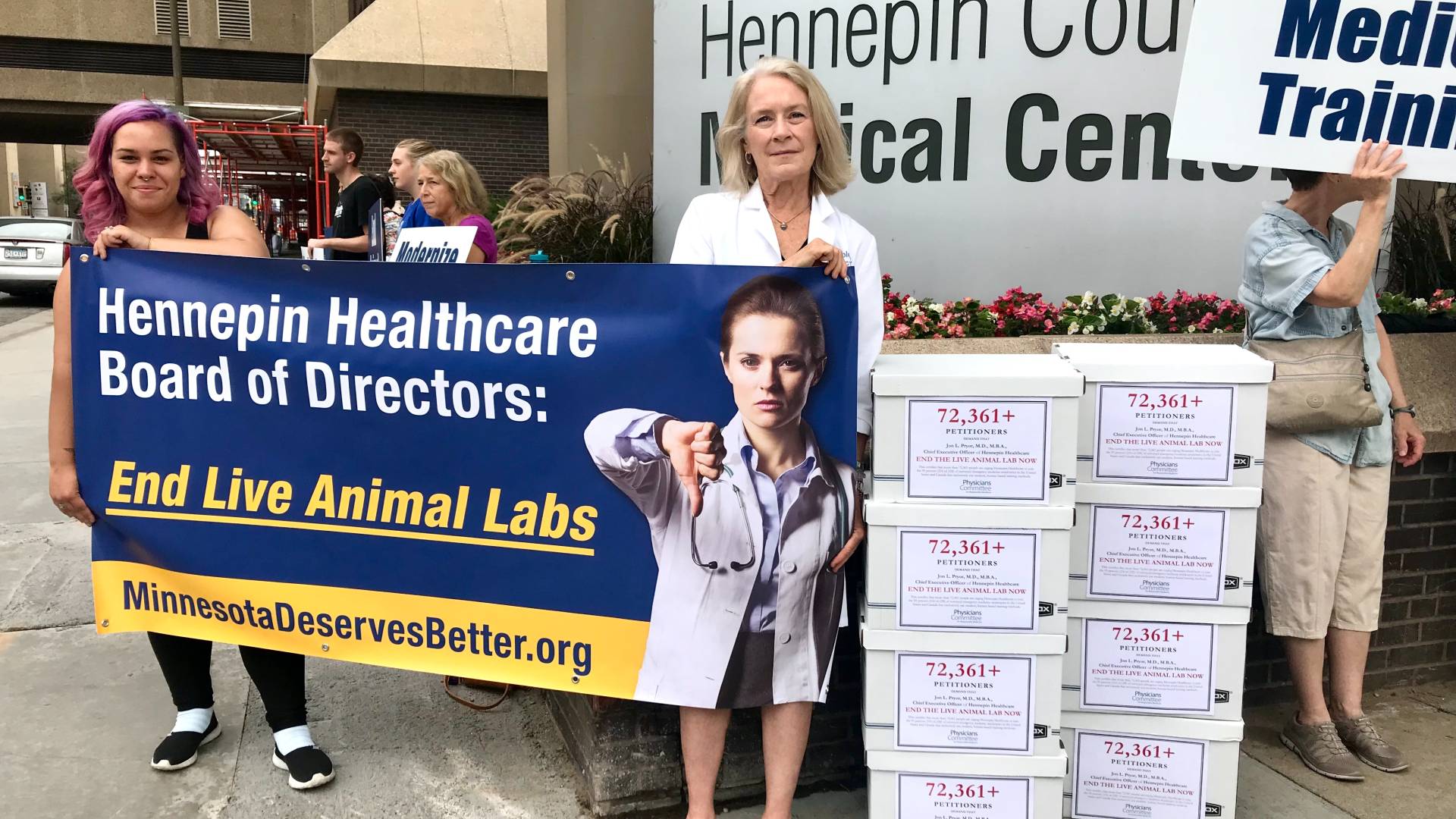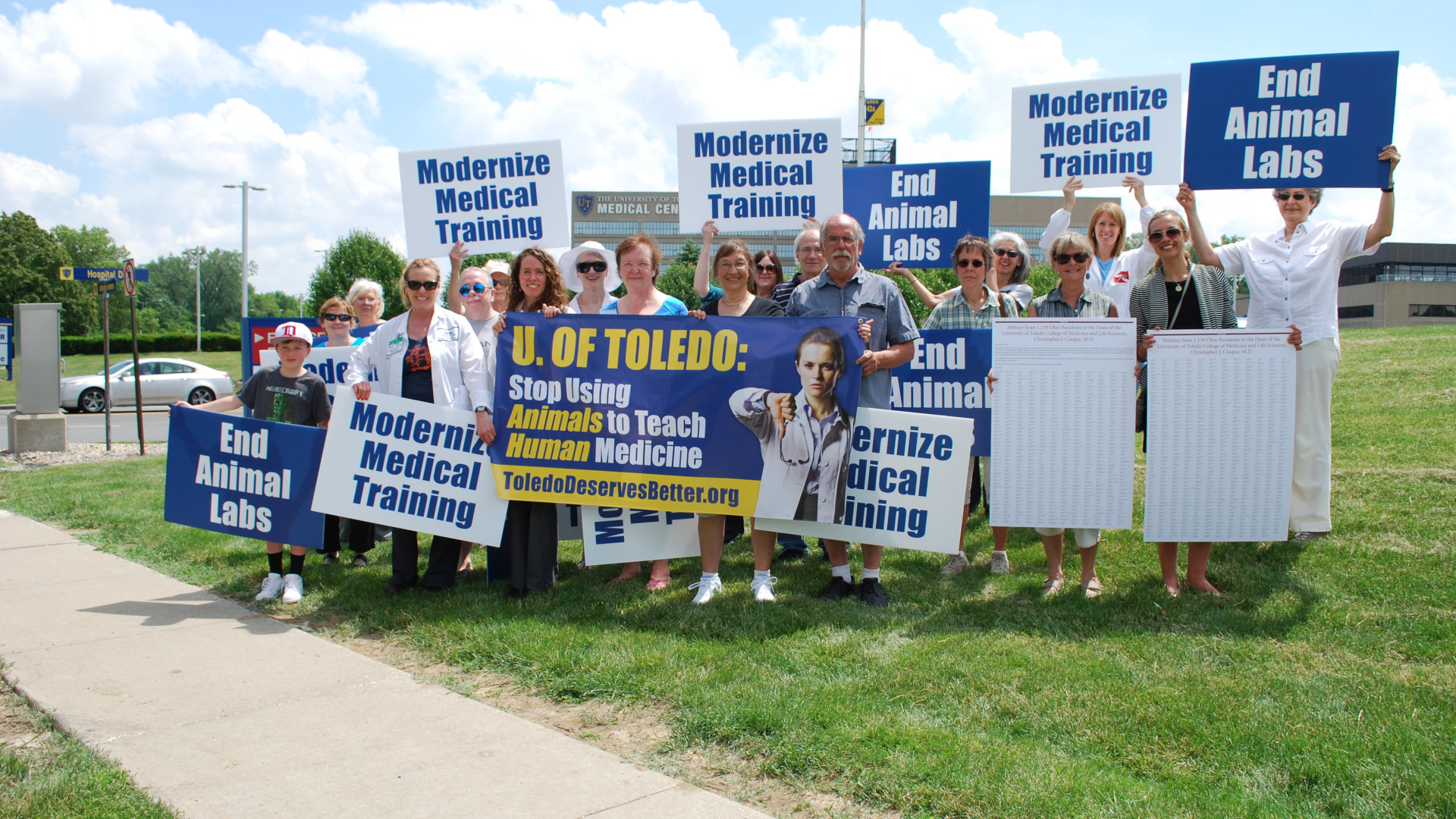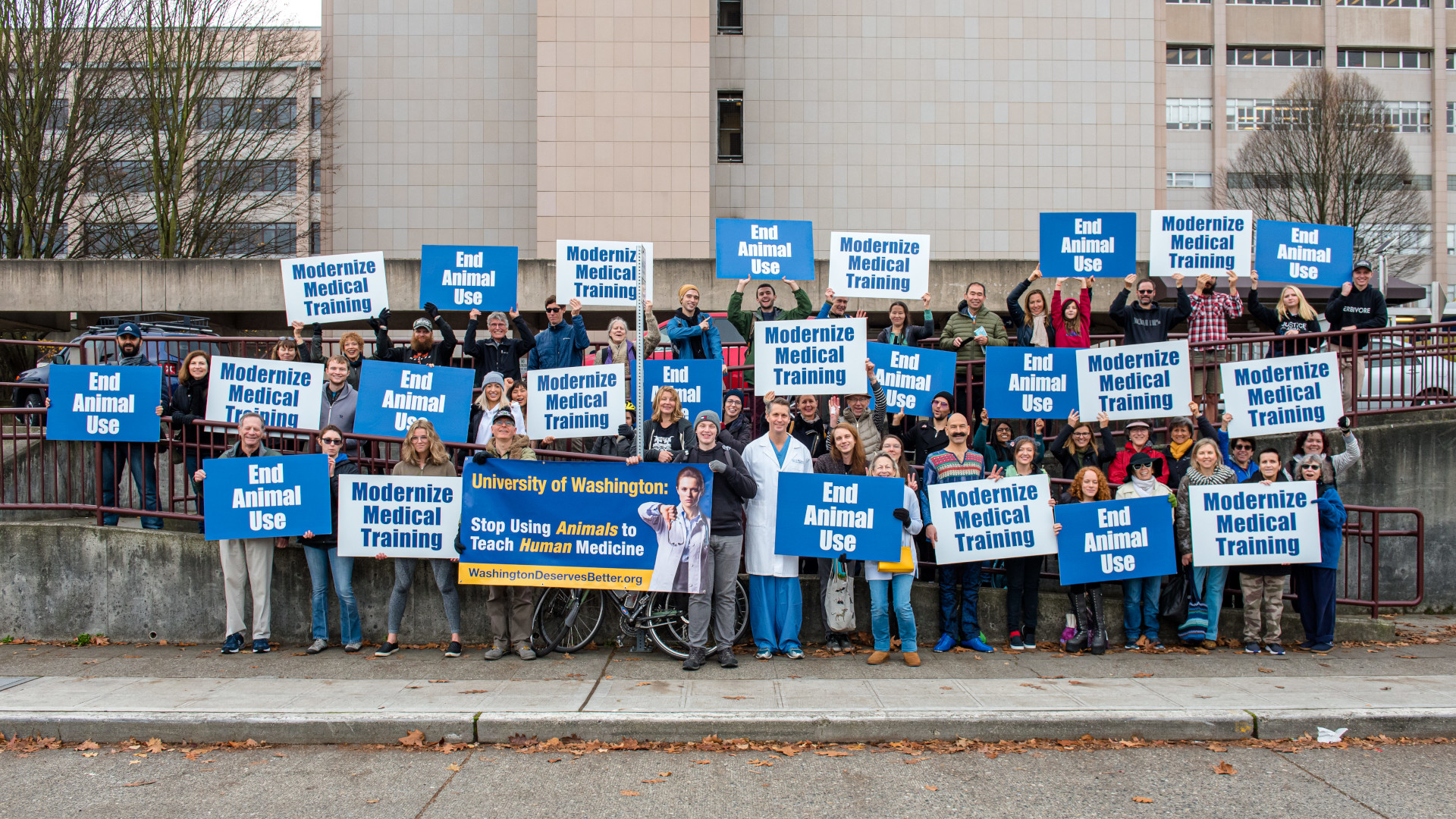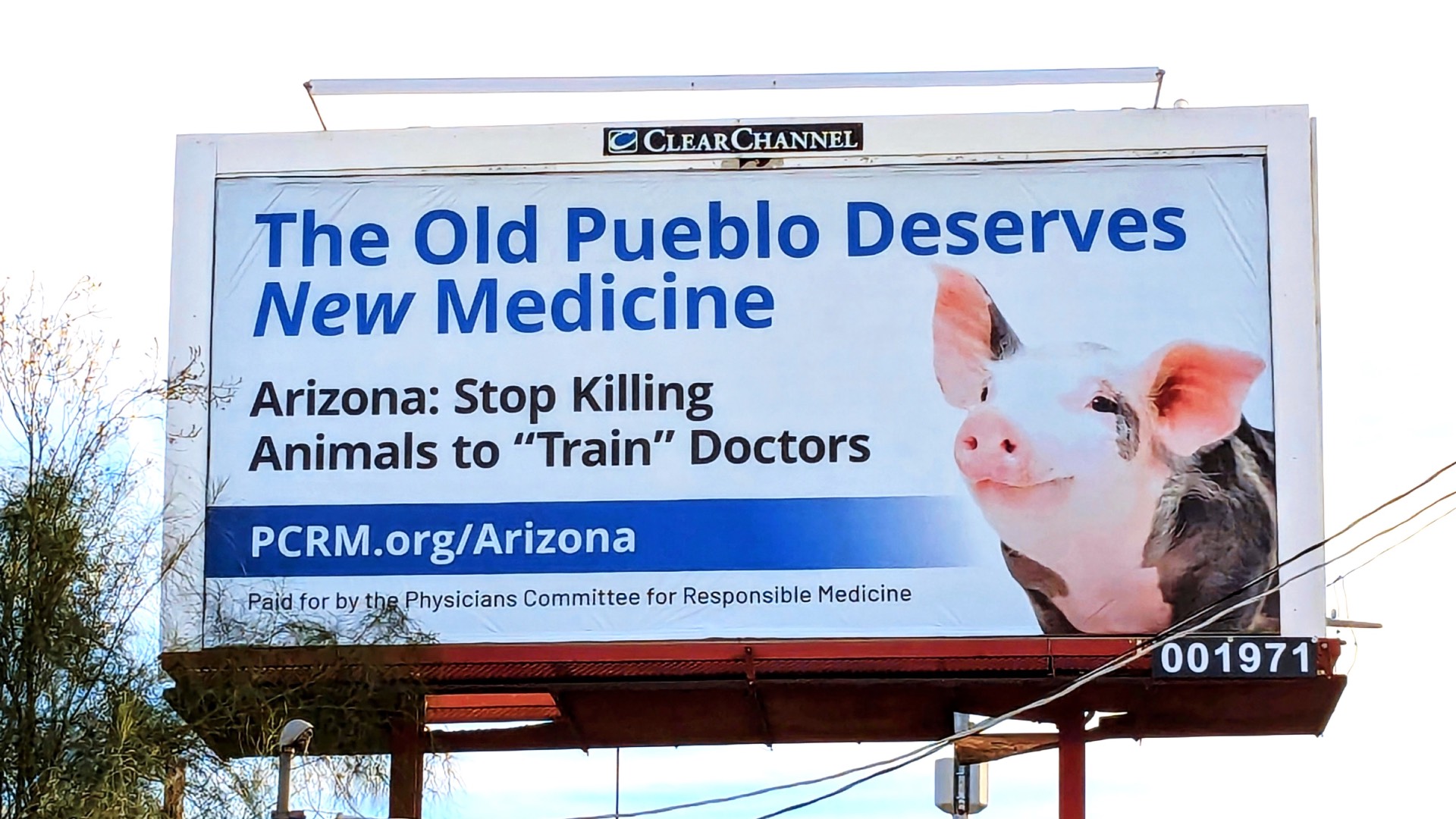Victories and Progress: Replacing Animals and Advancing Medical Training Through the Decades
Since its founding in 1985, the Physicians Committee for Responsible Medicine has been pushing to modernize medical training so that it is both human-relevant and animal-free. Substantial evidence supports this transition, and over the decades, we have established ourselves as the primary organization and resource working on this issue.
Medical Student Training
Beginning with its founding, and then accelerating after the introduction of a focused campaign in 2005, the Physicians Committee has helped establish a new era in medical school education.
The use of live animals in medical student training—which refers to the four years of training undergone to earn an MD or DO degree—predominantly occurred in two courses covering these subjects: physiology (including pharmacology) and surgery. The University of Mississippi was the last school in the U.S. and Canada to use live animals (pigs) to teach physiology, ending the practice in 2015. And the University of Tennessee College of Medicine in Chattanooga was the last school to replace animals for medical student training overall when it stopped using pigs to teach a surgery course in 2016.
After decades of hard work by the Physicians Committee, none of the 216 surveyed medical schools in the United States or Canada is known to use live animals for medical student training.
Pediatrics Residencies
Following medical school, physicians must complete an accredited training program as part of their graduate medical education in order to practice medicine in the U.S. or Canada. These residency programs take at least three years to complete and include comprehensive clinical and procedural training in various medical specialties (e.g., primary care, pediatrics, emergency medicine).
When the Physicians Committee began focusing on pediatrics residency programs in 2009, the procedure most commonly taught using live animals was intubation, where a tube is inserted into the trachea through the mouth, or sometimes through the nose. This procedure, which was often practiced repeatedly by multiple trainees on a live cat or ferret, can cause tracheal bruising, bleeding, scarring, severe pain, permanent injury, and even death.
At Washington University in St. Louis, pediatrics residents were instructed to force a breathing tube down the throats of live cats and ferrets. The animals were used over and over, living their lives in cages until they were eventually adopted out or euthanized. After years of pressure from the Physicians Committee, the university finally ended this practice in 2016.
Meanwhile, at Laval University in Québec City, Canada, pediatrics residents performed invasive procedures on live piglets. Trainees were instructed to make incisions in the animals’ chests and throats to insert tubes, insert a needle into the sac surrounding the heart, and surgically open a vein. The piglets were killed before the final procedure was performed. The Physicians Committee began reaching out to Laval in 2012 to encourage the university to replace animals and launched a public campaign when that effort was not fruitful. Over the years, we filed multiple complaints against Laval, coordinated advertising campaigns, held a physician-led demonstration, and helped thousands of individuals voice their concerns through our member petitions. Finally, in 2018, Laval confirmed that it had replaced animals with medical simulation.
In the past, most pediatrics residencies used animals to train their residents. However, today, none of the 225 surveyed pediatrics residency programs in the U.S. or Canada are known to use live animals.
Paramedic Training
In recent years, live animals have rarely been used to train paramedics, but the Physicians Committee has worked to replace the practice when it has occurred.
In 2016, we learned that the Montgomery County Hospital District (MCHD) was using live pigs to train its paramedics at Baylor College of Medicine in Houston. Trainees made incisions between the animals’ ribs to insert gloved fingers into their chest cavities, cut into their throats to insert breathing tubes, and inserted needles into their chests to remove fluid surrounding their hearts. Immediately after the we brought public attention to this issue with a federal complaint in 2017, the institutions announced an end to the practice. In its statement, MCHD cited its commitment to nonanimal training methods: "We believe it’s in the best interests of our patients and the community to provide our staff with the most up to date tools and methods of training."
In 2012, a Physicians Committee member informed us that the University of Washington was instructing paramedic students to cut into the necks of live pigs to insert breathing tubes in a procedure known as a surgical airway. The procedure was performed up to six times on each pig before the animals were killed. A doctor on our staff immediately initiated contact with university leadership and emphasized that airway simulators modeled on human anatomy are used in hundreds of medical training programs across the country. These devices mimic the stress of real-world emergencies and allow trainees to build confidence and acquire life-saving skills. When direct appeals to university faculty and leaders were ignored, the Physicians Committee began working with Washington state legislators, who wrote letters to UW and even introduced legislation to outlaw the use of animals for paramedic training. These actions resulted in the state providing a grant to the university to develop a new airway simulator and entirely replace animals in 2021—none of which would have happened without our efforts.
The Physicians Committee’s survey of paramedic programs shows that all 140 responsive programs west of the Mississippi River use only human-relevant training methods.
Emergency Medicine Residencies
Emergency medicine residency programs teach a broad range of advanced procedural skills to access, resuscitate, and stabilize acute trauma patients. Since 2013, the Physicians Committee has spearheaded the elimination of live animals in dozens of these residencies across the U.S.
Where animals have been and are still used in emergency medicine programs, the procedures often involve making an incision in animals’ (usually pigs’) necks to access the airway; inserting needles into their chests to remove fluid from the sac surrounding the heart; inserting a tube into their chest cavities to drain blood, fluid, or air to allow the lung to fully expand; and/or splitting open the animals’ breastbones to access their hearts for various cardiac procedures. The animals are killed after the training sessions, and in many cases, public records obtained by the Physicians Committee have revealed that the procedures continue even if the animals die while on the operating table.
At Hennepin Healthcare, a teaching hospital in Minneapolis, emergency medicine residents performed 20 invasive procedures on live rabbits and sheep. Trainees made incisions into the animals’ throats to insert breathing tubes, split open their breastbones to access their hearts and perform procedures, cut the skin and ligament at the lateral corner of their eyes, and drilled holes into their skulls. Following a Physicians Committee demonstration and public comments presented by spokesperson Kerry Foley, MD, during a Board of Directors meeting—which also included the delivery of more than 72,000 member petitions—the hospital finally confirmed in 2019 that it had ended the use of live animals.
In 2013, the Physicians Committee learned that Vanderbilt University in Nashville was using live pigs and sheep to train emergency medicine residents. Following attempts to communicate with university and program leadership directly, the Physicians Committee launched a public campaign in 2014 to inform the public about the practice. We then filed a federal complaint, coordinated multiple advertising campaigns, held demonstrations, and even delivered boxes containing more than 53,000 petitions to the office of the medical school dean. In 2021, our efforts paid off, and Vanderbilt modernized its training program by halting the use of live animals.
Also in 2013, the Physicians Committee turned its attention to the University of Toledo College of Medicine and Life Sciences (UT) when we learned that the university was approved to use up to 125 pigs annually to train emergency medicine residents and other medical professionals. Over the following years, the Physicians Committee filed local and federal complaints, held a physician-led demonstrations, coordinated multiple advertising campaigns, and even delivered a petition signed by 1,139 Ohio residents to the medical school dean. After nearly a decade of concerted effort from the Physicians Committee and our supporters, UT confirmed that it had replaced animals for training emergency medicine residents in 2022.
While the vast majority of emergency medicine residencies have replaced animals or never used them in the first place, some continue the practice (see: The Use of Animals in Emergency Medicine Residency Programs in the United States and Canada: An Ongoing Survey).
General Surgery Residencies
In 2018, given the progress that had been made in other training areas, the Physicians Committee turned its attention to surgery training and began surveying programs across the U.S. and Canada to determine if they were using live animals.
General surgery residency programs teach a wide range of skills in a variety of clinical settings to prepare physicians to become competent surgeons. Since 2018, the Physicians Committee has played a pivotal role in replacing live animals in nine of these residencies across the country.
Where animals are still used to teach general surgery residents, the procedures can involve making incisions into the animals’ (usually pigs’) chests, necks, and abdomens to insert devices and remove organs, such as their kidneys, spleens, and gallbladders; transecting their intestines to then suture or staple them back together; and spreading open the pigs' ribs to access their lungs and hearts. If the animals survive these invasive procedures, they are killed following the training sessions.
One of the first surgery programs to replace animals after the Physicians Committee’s outreach was the Medical College of Georgia (MCG) in Augusta. As of 2018, MCG residents were making incisions into the throats and chests of live pigs to insert needles and tubes, and performing procedures on their spleens, kidneys, livers, and gallbladders. Following our public campaign, MCG replaced animals for training surgeons in 2020!
The Physicians Committee launched its first general surgery campaign in 2019 when it was tipped off that the University of Washington had reinstated live animal exercises after a five-year lapse—even over the strong objections of a member of the university’s animal research oversight committee. The Physicians Committee jumped into action, urging university leaders to reconsider the change, and then launched a public campaign when that effort had been exhausted. We also filed a federal complaint, held a physician-led demonstration, and launched an advertising campaign. Then, in 2022, UW finally announced an end to this controversial practice.
In 2019, we learned that the University of Arizona College of Medicine in Tucson was using live pigs to train its surgery residents. Over the following years, the Physicians Committee filed a federal complaint, held a physician-led demonstration, sent a letter from 163 physicians to Governor Katie Hobbs and the Arizona Board of Regents, and delivered thousands of member petitions. Finally, the university confirmed that it had replaced animals in 2025!
While most general surgery residencies programs have replaced animals or never used them in the first place, some continue the practice (see: The Use of Animals in General Surgery Residency Programs in the United States and Canada: An Ongoing Survey).
Advanced Trauma Life Support (ATLS) Programs
To manage some of the most acute trauma injuries, the American College of Surgeons developed the Advanced Trauma Life Support (ATLS) course. This course is offered to physicians and other qualified health care professionals to provide the skills for assessing and managing severely injured patients. In ATLS courses, trainees are instructed to perform many of the same procedures that emergency medicine residents practice, including establishing a surgical airway, removing fluid from the sac surrounding the heart, and draining fluid or air from the lungs.
In 2001, the American College of Surgeons stated that “wherever feasible, alternatives to the use of live animals should be developed and employed” and endorsed the use of Simulab’s TraumaMan System in ATLS courses. TraumaMan is a high-fidelity human-patient simulator with lifelike skin, subcutaneous fat, and muscle, and its replaceable tissues provide each trainee with a first-cut experience. As of Jan. 1, 2015, the U.S. Department of Defense prohibited the use of animals for ATLS courses, concluding that “sufficient simulation models [are] available to meet medical education and training needs.”
For years, many ATLS programs used live dogs to teach these invasive procedures, including the University of Michigan’s (UM), which the Physicians Committee first uncovered. After the university ignored our outreach, we went to the media. Our billboards near Ann Arbor brought intense media attention to the issue, our supporters sent more than 20,000 email petition to UM, and within a few weeks, the university announced in 2009 that it had replaced dogs with the TraumaMan System.
In 2009, the Physicians Committee learned that Queen’s University in Kingston, Ontario, was using live pigs it its ATLS courses. As is common practice for our campaigns, we filed a Freedom of Information Act request to obtain public records about what the university was doing to the animals during the training courses. The university denied our request, citing a vague provincial statue, which we appealed, and the university again denied, before we entered mediation through a third-party. However, before that process was complete, we reached a powerful milestone: In 2010, the course director sent the Physicians Committee a letter announcing that the university had stopped using animals and replaced them with the TraumaMan.
Also in 2009, the Physicians Committee learned that Baystate Medical Center in Springfield, Mass., was using live pigs in its ATLS courses. Over the following years, we delivered thousands of member petitions urging the medical center to replace animals, filed a federal complaint, a state cruelty complaint, held three physician-led demonstrations, and even posted billboards that featured a pilgrim with a stethoscope that declared “Baystate Medical Center: Stuck in the Past. End Animal Use for Medical Training." Then, in 2019, Baystate replaced animals!
As of April 2025, 99% of surveyed ATLS programs in the U.S. and Canada use only human-relevant training methods, but one program—taught by Sanford Health staff at North Dakota State University in Fargo—continues to use live animals.
Looking Ahead
The Physicians Committee and its supporters continue to work toward the day when animals will be replaced in all areas of medical training, a change that will benefit doctors, patients, and animals alike. Please visit our Take Action page to learn more about our active campaigns.
Read More About Our Victories
- News Release | The Physicians Committee Congratulates Duke University on Replacing Animals in Medical Student Curriculum | Mar. 20, 2024
- News Release | UW Shelves Controversial Lab Following Campaign by National Physicians Group | Sep. 2, 2022
- News Release | Following Public Outcry, UVA Halts Live Animal Use for Surgery Training | Sep. 14, 2020
- Good Medicine | Physicians Committee Ends Animal Use in Pediatrics Training | Autumn 2018
- News Release | All Surveyed Pediatric Residency Programs in U.S. and Canada No Longer Use Animals for Training | Jun. 22, 2018
- News Release | Unauthorized Use of Live Animals Abord San Diego Navy Ships Exposed | Jan. 12, 2018
- News Release | Cleveland Clinic Ends Involvement in Live Dog Training Lab| Aug. 22, 2017
- Good Science Digest | Incremental Changes Herald Big Victories | Jul. 27, 2017
- News Release | Statement from the Physicians Committee for Responsible Medicine on Morristown Medical Center Eliminating the Use of Live Animals for Emergency Medicine Training | Nov. 18, 2016
- News Release | Physicians Committee Commends Washington University for Ending Animal Labs | Oct. 18. 2016
- Good Medicine | The End of Animal Laboratories in Medical Student Educations | Autumn 2016
- Blog | Blood and Guts on Capitol Hill | Oct. 25, 2013
Support our work. Become a member.
